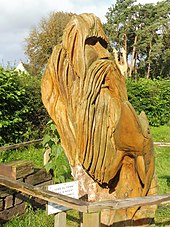Folk art
The folk art , sometimes folk art called, refers to the artistic and creative work beyond the traditional and modern arts , mostly involved in traditional handicraft or domestic production.
origin
The works of folk art are mostly of anonymous origin, their producers have not completed any aesthetic or artistic training in the narrower sense . The Austrian art historian Alois Riegl coined the term “folk art” in 1894 . The discovery of folk art by art history at the end of the 19th century as a historically and aesthetically valuable part of culture went hand in hand with the increasing disappearance of this phenomenon in industrializing European societies. The increasing loss of craft traditions towards the end of the 19th century in Central and Western Europe deprived folk art of the basis of its work. Based on the theories of primitivism , folk art, as well as the so-called primitive art of the non-European countries, received special attention also and especially from modern artists at this time . The greatest scientific interest in folk art came from the first international folk art congress in Prague in 1928 with over 200 participants. This resulted in the Commission Internationale des Arts et Traditions Populaires (CIAP, now SIEF ), an international commission for the promotion of folk art research.
Collections

Numerous private individuals collected folk art objects, which became rarer with industrialization. The first private collections and local museums came into being - also mostly on private initiative . Examples are the Hüsli local history museum or collectors such as Georg Essl I or Oskar Spiegelhalder . Folk arts can have a regional or a supra-regional character, depending on their handicraft basis or their relation to a special custom . As a rule, folk arts originate in the landscape or traditions and traditions narrowly delimited according to tribes , but they also process impulses from high art (e.g. rural furniture painting influenced by baroque church art). They are often full of colorful symbolism and use local materials. Folk arts with a more regional character include, for example
- Furniture : decorative painting , wood painting , pyrography
- Textiles : weaving , embroidery , braiding , batik , bogolan , patchwork / quilt , traditional costumes
- carving
- pottery
- Jewellery
- Forms of settlement
- Folk music , folk dance and many folk songs
In modern times , supra-regional and global forms of folk art developed. This includes
- Shanties
- Blues , which takes up musical elements from different continents and smoothly merges into professionalized forms of music
- graffiti
Since the second half of the 20th century, the term popular art has been used to denote current folk art. B. the modern mass media to include the individual aesthetic production on site (e.g. West Africa). Especially in industrial societies today, folk art is usually used to describe a production for tourist needs that is based on traditional motifs and techniques. Something similar can also be observed in European folk art, which today also mostly works for tourist needs or specialized collectors. This applies in particular to objects that were previously intended for actual use in everyday life (clothing, tools, etc.) but are now purely decorative objects.
See also
Web links
- Iván Balassa – Gyula Ortutay: “Hungarian Folklore” with a chapter on decorative folk art
- Folk art museums at webmuseen.de
- CIOFF®: International Council of Organizations of Folklore Festivals and Folk Arts
Individual evidence
- ↑ Nina Gorghus: The International Folk Art Congress 1928 in Prague. In: Ákos Moravánszky (Ed.): The distant village. Modern art and ethnic artifact. Böhlau, Wien 2002, pp. 125–135, here p. 125
